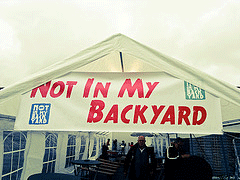
Photo by flickr user Marco Raaphorst, CC BY 2.0
I am accustomed to think of NIMBY (“Not in my back yard”) as referring to suburban homeowners who want to keep out affordable housing, bars and cafes, public transit and anything else that smacks of urban life and might interfere with property values. But in an article that appeared on Planetizen the other day, Matthew Kiefer suggests that NIMBY has become an urban phenomenon as well.
Kiefer argues that many people who are moving to city neighborhoods want to have city life without city inconveniences. I would guess that they may even desire “edginess,” which could be loosely defined as diversity and neighborhoods that are a little rough around the edges. Yet they rise up fiercely against new development, regardless of whether or not it has benefits for the community they have made their own.
If they hope to make good with these urban NIMBYists, Kiefer says, developers must not just offer to mitigate the specific impacts like noise and traffic of their projects. They can’t just offer to share their big new parking lot with some other local user, or pass out a flyer to new tenants in their building advertising the benefits of biking to work.
They have to give residents something even more concrete, like a community center, a new school, or housing that meets the needs of a particular group such as those with physical handicaps or low incomes. Of course, if the NIMBYists consider these amenities to be threats to their property values, it won’t help a developer to propose them.
In addition, Kiefer says developers are wise to invite would-be NIMBYists into the design process for their buildings, to the extent it is feasible. The time it takes for a project to actually be built will be much longer, but there’s a better chance the project will in fact happen, and with community support.
The point is that it isn’t enough for developers in already crowded urban settings to offer token mitigation for their projects. They are expected to give something substantial back to the place they have set foot in.




I couldn’t agree more with Kiefer’s points. We need to sell community development and urban density, and we can’t expect to sell it without community benefits. I for one would like to see a lot more green space and biophilia integrated into urban projects, but as Kiefer suggests that are other assets that can be contributed as well.